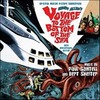Soundtrack Information
Music From
Music By
Track Listing
Related Albums

Voyage to the Bottom of the Sea: 50th Anniversary Limited EditionLimited Edition of 2,000 Copies
La-La Land Records (LLLCD 1187)Released: November 15, 2011
Format: CD (56 min)
Review: Voyage To The Bottom Of The Sea
3 / 5 Stars
Travel back in time with me to 1961, when visual effects were not so spectacular and science fiction did not rely on any basis of science fact to create a viable story line. While Irwin Allen's Voyage to the Bottom of the Sea may seem "hokey" by today's standards, its effects and story line were extremely advanced for its time and the movie is still considered a "classic" by many.† The movie was so successful that it also spawned a TV show that ran for 4 years (1964-1968).
Voyage to the Bottom of the Sea follows the adventures of Admiral Harriman Nelson (Walter Pidgeon) and the crew of the SSRN Seaview, the worlds first privately owned nuclear submarine.† As the movie starts, we join the Admiral as the Seaview is just completing its first run trials under the Artic Ocean.† All hell breaks loose when the Van Allan Radiation Belts catch on fire.† For those with little or no knowledge of astronomy, the Van Allan Radiation Belts are basically the charged particles that interact with solar winds and the Earth's magnetic field and produce the Aurora Borealis (Northern/Southern Lights).† Luckily for Earth, Admiral Nelson is also the smartest scientist on the planet, so after a few calculations on his slide rule (yes, slide rule!) he determines that the only way to save the planet is launch a nuclear missile into the Van Allan Belts. Most people disagree with him and soon the admiral finds him self in a race against time as the Earth moves closer to boiling point, the nations of the world are sending warships and submarines to stop the Admiral, and he is pushing his own crew ever closer to mutiny.
Voyage to the Bottom of the Sea is filled with many of the great underwater stereotypes we have come to know and love.† We have the super-advanced underwater sub with large glass windows, everything is "nuclear this" and "atomic that", and we even have our classic attack of the giant rubber squid tentacles!
The soundtrack for the Voyage to the Bottom of the Sea is a must have for any nostalgic movie music lover.† The first track, "Main Title - The Super Sub" features lyrics performed by Frankie Avalon (sorry, there's no Beach Blanket Bingo on this cruise).† This breathy anthem is nothing like the rest of the score, but since Frankie plays the supporting role of Lt. Danny Romano in the film, the producers probably figured he would help attract some of the younger viewers at the time.
The score by Bert Shefter and Paul Sawtell is good for several reasons.† First, it quickly develops a theme for the Seaview and incorporates portions of that into almost every other piece.† A "classic" orchestra performed the entire score - there are no electric guitars or synthesizers in this music.† Lots of percussion, scales up and down a harp and strong brass are used to let you know that something bad is happening.† This creates a very nostalgic atmosphere that can be compared to the classic Universal horror movies like Creature from the Black Lagoon.
Second, the score is a good example of how a soundtrack should propel a film.† Let's face it; if we removed the music completely, the film would suck by today's standards.† There's never really a "close up" of any actor and you know the sub is a tiny little model floating in somebody's bathtub. The dialog is bland, even when times are tense, and every body is walking on and off the set like itís a high school play.† Add the music back in and the subtle clues to how you should be feeling begin to work their magic.† "Brave Volunteers / Cable Search / Dangerous Grounds / The Squid Attacks" is a good example of that I mean.† The piece begins with the familiar "Seaview theme"; every time you hear this music you are almost guaranteed a shot of the sub zooming along under the water.† Woodwinds and strings sing along with a familiar but intermittent harp as our heroes swim around under the water and then the brass kicks suddenly enough to make you wet yourself when the giant squid shows up.†
Finally, I feel that the score makes good use of a harp to create suspense and also carry the story forward.† A very good example of this is "Fire In Red / Fresh Air / The Ghost Ship".† The piece starts with the same familiar rapid scales on the harp that we have heard elsewhere in the score, aided again with strong of brass and strings.† As the track progresses, the harp is nothing more than a few faint notes fading in and out of the background to help fuel the suspense of an impending doom.
While this motion picture score in not the best out there, it is an extremely good example of how soundtracks were "back in the day" and how a soundtrack should carry a film in present times.† If you have never seen Voyage to the Bottom of the Sea, then I strongly encourage you to rent a copy.† Itís a great popcorn movie for a Saturday afternoon and you would be surprised by how many plot similarities it shares with The Hunt for Red October.† It makes you wonder if Captain Ramius didn't learn a few things from Admiral Nelson.
-
Click stars
to rate.
If any information appears to be missing from this page, contact us and let us know!

